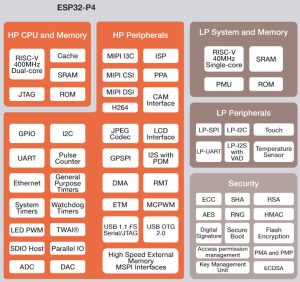- ESP32-C6 – ICs, modules and SDK imminent
Dual RISC-V cores (160MHz + 20MHz), Wi-Fi 6 (2.4GHz), Bluetooth 5 (LE), 802.15.4 protocol - ESP32-P4 – just announced
Triple RISC-V (400MHz + 400MHz + 40MHz), AI instructions, no wireless
ESP32-C6
ESP32-C6 has a 160MHz RISC-V core for performance and 20MHz RISC-V processor for power-saving, 320kByte ROM, 512kbyte, and external flash capability.
On-board are transceivers for 2.4GHz Wi-Fi 6 and Bluetooth 5 (LE) and the 802.15.4 LR-WPAN (low-rate wireless personal area network) protocol.
“ESP32-C6’s support for IEEE 802.15.4 and Wi-Fi radios, along with Bluetooth 5 (LE) connectivity, enable customers to build Matter-compliant Wi-Fi end-point devices and Thread end-point devices, thus achieving interoperability in smart-home devices,” according to the company. It “can be used in Matter-related solutions, such as Matter gateways, Thread border routers or Zigbee-Matter bridges”.
Interfaces include SPI, UART, I2C, I2S, RMT, TWAI (two-wire automotive), PWM (including motor control), SDIO (SDcards), 12bit ADC and temperature sensor.
Security
ESP32-C6 comes with RSA-3072-based secure boot, AES-128/256-XTS-based flash encryption, digital signature and an HMAC peripheral for identity protection, as well as cryptographic accelerators.
A trusted execution environment is there for privilege separation amongst chip features and therefore software separation.
Development support is planned through v5.1 of the company’s ESP-IDF software environment (scroll down for link, v5.0 is the current version). “For customers who would like to use ESP32-C6 as a communications co-processor with an external host, ESP-Hosted and ESP-AT firmware can also be available. ESP32-C6 will also be supported through ESP RainMaker system for building AIoT products,” it said.
As is usual with Espressif SoCs. it will be available in IC, module and module-like dev board forms – little information is yet available on these.
ESP32-C6 is scheduled to be available through the Espressif’s online store, Akizuki, Digikey and Mouser, and Adafruit is developing products with the processor.
 ESP32-P4
ESP32-P4
ESP32-P4 has a 400MHz dual core RISC-V CPU supporting single-precision floating point and artificial intelligence extensions, plus a 40MHz low-power core.
The core system has 8kbyte zero-wait TCM RAM for fast data buffering or storing time-critical sections of code, and 768kbyte sram which “can become accessible as cache when external PSRAM is available”, said Espressif.
As well as external PSRAM support, there is also support for external flash.
More security
Against hacking, the ESP32-P4 has secure boot, flash encryption, crypto accelerators abd a true-random number generator. “With the help of the digital signature peripheral and a dedicated key management unit, ESP32-P4 ensures that private keys are generated on the SoC itself and are not compromised by any software in plain text or by any physical attacks,” claimed the company.
The IC supports hardware access permission management and privilege separation.
For cameras and displays, there is has support for MIPI-CSI with integrated ISP and MIPI-DSI, and there will be capacitive touch inputs.
Related accelerators include H.264 encoding and a pixel processing accelerator suitable for GUI development.
There will be 50 programmable GPIOs, “more than those of any other Espressif SoC to date”, it said.
Peripherals include: SPI, I2S, I2C, PWM for LEDs, PWM for motors, RMT, ADC, DAC, UART, TWAI, USB OTG 2.0 HS, Ethernet and SDIO Host 3.0.
Wireless-capable ESP32-C6 product page, and this GitHub page lists which features will be supported by ESP-IDF v5.1
